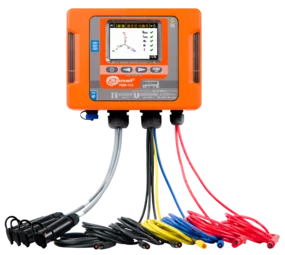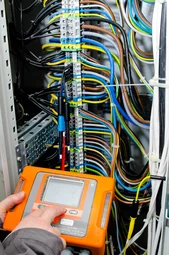Description
Class A remote analysis
The Sonel PQM-711 versatile power quality analyser for remote
analysis in the A class is a device suitable for use on all
types of networks with a rated voltage range from 110 V to 1000 V
either directly or indirectly through transformers.
Based on advanced technology, the Sonel PQM-711 power quality
analyser allows comprehensive measurement, analysis and recording
of 50/60 Hz
power network parameters and power quality according to the
European standard EN 50160.
Features
- Remote control and data transfer through a
built-in GSM modem.
- Anti-theft feature – SMS notification in the
event of position change (built-in GPS receiver).
- Real-time clock synchronized to GPS
protocol.
- Remote control of the analyzer via software:
Sonel Analysis (Wi-Fi and GSM for Windows) or
Sonel Analysis Mobile
(Wi-Fi for Android).
Measured parameters
- Voltages L1, L2, L3, N, PE (five
measurement inputs) – average, minimum, maximum and
instant values within
the range up to 1000 V, interoperability with voltage
transducers.
- Currents L1, L2, L3, N (four measurement
inputs) – average, minimum and maximum values, current
measurement within the range
up to 6 kA (depending on applied current clamp),
interoperability with current transducers.
- Measurement of control signals up to 3000
Hz.
- Crest factors for current CFI and voltage
CFU.
- Frequency within the range of 40...70
Hz.
- Active (P), reactive (Q), distortion (D) and
apparent (S) power with the type of reactive power
(capacitive and inductive).
- Calculation of reactive power using the
Budeanu method and IEEE 1459 method.
- Active energy (EP), reactive energy (EQ),
apparent energy (ES).
- Power factor, cosφ, tanφ.
- K factor (transformer overload caused by the
harmonics).
- Up to 50th harmonics for voltage and
current.
- Interharmonics measured as groups.
- Total Harmonic Distortion (THD) for voltage
and current.
- Short-term (PST) and long-term (PLT) flicker
(IEC 61000-4-15 class A).
- Unbalance of voltage (IEC 61000-4-30 class A)
and current.
- Current events detection including waveforms
recording.
- Current and voltage events recording with
waveforms (up to 1 s) and RMS1/2 graphs with 30 s maximum
recording time.
- Current and voltage waveforms recording after
each averaging period.
Wide range of mains to analyze
- With rated frequency 50/60 Hz
- With rated voltages: 58/100 V, 64/110
V, 110/190 V, 115/200 V, 120/208 V, 127/220 V, 133/230 V,
220/380 V, 230/400 V, 240/415 V, 254/440 V, 290/500 V,
400/690 V
- Direct current
- Systems:
- single-phase
- split-phase with common N
- three-phase – WYE with and without N
conductor
- three-phase – Delta
- three-phase – 2-element WYE without N
conductor (Aron/Blondel)
- three-phase – 2-element Delta
(Aron/Blondel)
- with current and voltage transducers
Capabilities
PQM-710 has a built-in GPS receiver ensuring real time clock
accuracy and an integrated GSM modem that facilitates remote
analyzer operation.
Furthermore, PQM-711 is also equipped with a transient
recorder (sampling frequency 10 MHz, voltage range up to
±8000 V).
An additional trump card of the analyzer is the built-in Wi-Fi
communication module, providing a number of advantages: no
restrictions on file transfer,
no data transfer costs, use of local wireless infrastructure... This
gives the user the opportunity to adapt to the conditions prevailing
on the site.
They can supervise measurements from a convenient location – for
example, an area without electromagnetic interference – using a
laptop, smartphone or tablet.
Displaying data
PQM-710 can be operated using a touch screen computing device
equipped with Sonel Analysis software (Windows) or Sonel
Analysis Mobile app (Android).
The user can supervise the measurements and conduct diagnostics
while maintaining mobility – he doesn’t even have to be near the
analyzer. In typical
applications, the device plays the role of a remote display and an
intermediate storage of measurement data with the functionality of a
router. Therefore,
the user can also connect to it using a wireless network – for
example, to transfer the collected registrations to a desktop
computer.
Application
PQM-710 is widely used in the professional power industry. It
provides full 4-quadrant analysis, meeting the needs of energy
consumers and producers,
such as renewable energy, including photovoltaic and wind farms. It
enables forecasting failures in distribution networks. It provides
analysis of
the load capacity of networks and transformers, as well as recording
their current states. In addition, it is powerful investment tools.
Thanks to PQM-711, the user will obtain the necessary data for
development of power infrastructure, predict potential problems, and
finally – verify
the correctness and quality of implementation.
SONEL ANALYSIS
Sonel Analysis software – application delivered as standard
accessory, indispensable for working with PQM-series analyzers.
Depending
on the mating instrument used, the software enables:
- analyzer configuration,
- data reading from logger,
- preview of network parameters in real time
(with capability of reading via GSM modem),
- deletion of data in the analyzer,
- data presentation in tables,
- data presentation in charts,
- data analysis and generating reports in
compliance with standard EN 50160 (reports) and other user
defined reference conditions
- also for PV micro-installations up to 50 kW, a breakdown
for active power states P>0,
P<0 and P=0 and taking into account the graphs Q1=f(U1/Un)
and cosφ=f(P/Pn),
- independent support of multiple
analyzers,
- analyzer firmware updates.
The software enables readout of selected parameters and their
visualization in real time. These parameters are measured
independently from the registration
saved on the memory card. The user can view:
- charts of voltage and current progression
(oscilloscope),
- charts of voltage and current over
time,
- phasor diagram,
- measurements of multiple parameters,
- harmonics and harmonic powers (estimating the
direction of harmonics),
- interharmonics.



